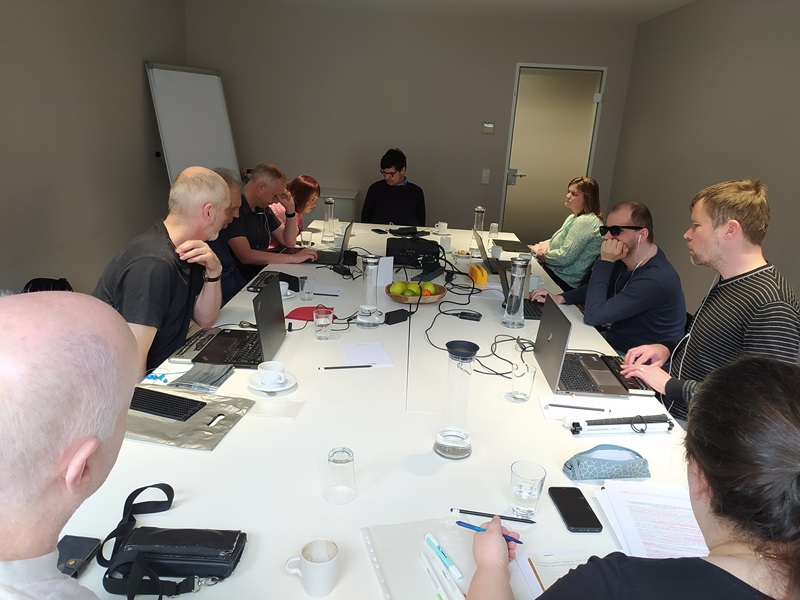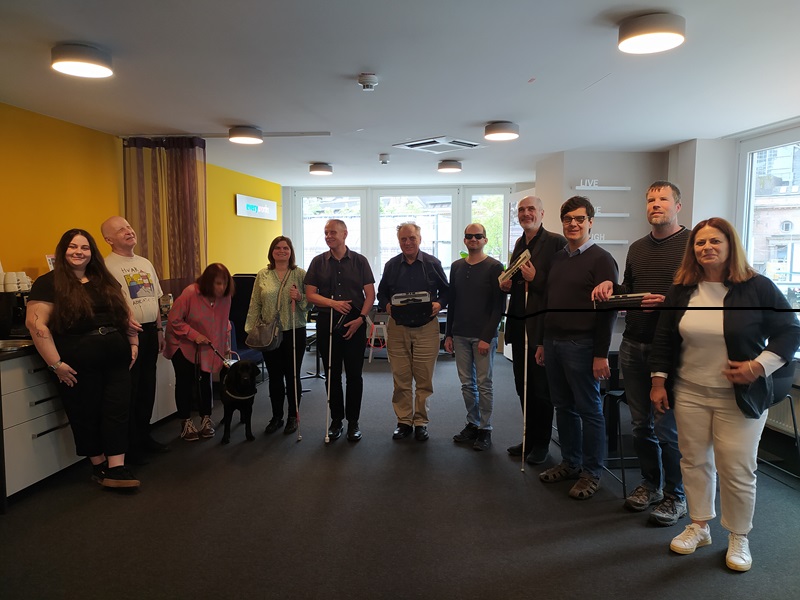After worldwide research on the usage of Braille displays with over 900 participants, EBU’s Braille Working Group discussed major important requirements for the improvement of the access to electronic Braille with producers during the Sight City fair held in May in Frankfurt, Germany.
A number of suggestions for improvement were made in the areas of quality and durability, connectivity and driver unification, operating standards as well as manuals and training. Communication between users and producers will go on.

Members of the EBU Braille WG around the table.
From December 2023 to the end of February 2024 the Braille working group of the European Blind Union conducted the survey Braille Display Usage. This survey offers an overview of Braille display usage and Braille display users’ expectations. In this survey responses from 912 respondents from 59 countries were collected. Most of them were Braille users, but responses from educators and braille trainers were also included. The analysis of all responses is available on livingbraille.eu, the portal which represents a Braille resource website of EBU. A conclusive document, Results of the survey “Braille Display Usage”, offers a complete description of the findings and suggests specific areas for improvement in the future.
The results of the survey served as a powerful cornerstone in the discussions with the public and with Braille display manufacturers during the in-person meeting of the EBU Braile Working Group in May 2024 in Frankfurt, Germany.
The SightCity exhibition, with tens of Braille producers exhibiting their products, was a invaluable opportunity for the group members to not only meet and see different Braille tools, but also to bring together the public and Braille display producers in a conference room to openly discuss the survey participants’ opinions. The five areas most frequently mentioned in the survey of Braille display usage were chosen for discussion: namely quality and price of Braille displays, connectability and drivers, functions and operability, bluetooth connectivity and training materials. The public discussions confirmed yet another important item, uniformity in usage of Unicode Braille patterns within the Braille display internal environment.
All these areas were discussed during the meeting with Braille display producers. We were very pleasantly surprised by the high number of companies joining us for discussions. We went through all the areas and laid out main important findings.
The members of the Working group pointed out the concern of the survey participants of the decreasing quality of Braille dots or Braille cells installed in the devices. Producers assured us, however that the quality is thoroughly tested by blind users. The recent reduction in dot quality might be a result of the still on-going search for good and reliable technology with lower costs leading to potentially more affordable braille displays in the future. Nevertheless, we expressed strong advocacy for reliable and long-lasting Braille cells with evenly levelled dot heights. The Braille Working Group will create a checklist of basic functionalities and features of braille displays for users to be able to make an informed decision when buying a new Braille display. Thus producers can compare their displays against this checklist in order to have minimal requirements.
Additionally, it was proposed:
- to create an article on livingbraille.eu about the users’ actions to keep their Braille displays clean and in good shape and to visit the dealers for regular maintenance if possible;
- producers should be more open for feedback, establish a channel for direct feedback from the users, not only through the dealers;
- Create the possibility to exchange one cell instead of a segment or even the whole display;
- encourage all producers to implement Unicode Braille as part of the Braille device itself;
- there should be a temporary hire of braille display offered in the period of user's one is being repaired.
In the area of connectivity issues very positive information from Braille display producers was received. There is a real possibility of quite an elegant solution in the near future. Human Interface Device (HID) standard is widely known as a solution for the devices’ connectivity in all the platforms and devices. HID for Braille displays exists and recent developments suggest its implementation in most used platforms quite soon. Braille users can hope this will solve a lot of problems participants mentioned in their responses.
The guests from producing companies also suggested to pay attention to the updates of their operating system, screen reader and firmware of the Braille displays. Many issues are being solved within these updates so users can avoid repeatedly facing these problems. For example, on connectivity issues, a lot was solved within the last year, therefore producers encourage all users to check for all available updates. EBU Braille Working Group will closely follow the HID implementation and inform about this on livingbraille.eu.
As for the operability of Braille display buttons and functionality and also for training materials Braille Working Group members asked producers to consider making better materials available online, so that users do not need to rely only on written guidelines, but can learn from more interactive materials. They suggested podcasts, video or audio manuals, paying attention to the different language options also for non-English speaking users. Internet and producers offer this kind of material, but the majority of it is in English. Producers cannot rely on the distributors to carry out this mission in their countries.
The EBU Braille Working Group will collect and create more materials about Braille displays, producers, manuals and more on the livingbraille.eu portal. The website will be developed and filled with materials, links to different resources. It was also proposed to use artificial intelligence to make controlling Braille displays and screenreaders easier, e. g. by voice commands.
The discussions with Braille display producers have just been opened and established, The EBU Braille Working Group will continue to further these discussions and meetings in the future to provide more information and play an important role in the shared dialogue between users and Braille display producers.
EBU wants to thank Braille producers for taking part in our efforts and meeting with us. Their positive attitude gives us hope for better communication in the area of digital Braille in the future.
We would also like to encourage all users to visit SightCity exhibitions in the future. It is a wonderful opportunity to literally touch the devices before purchasing. The EBU Braille Working Group expressed a strong belief that a well informed choice of Braille displays will play a key role in the users overall satisfaction with digital Braille usage.
The Braille Working Group of the European Blind Union
The Braille working group was established in 2020 and since then members of this group have been working on various projects to promote Braille and improve its usage in all areas of life for blind People. In 2022 the group presented a video about the importance of braille, which is available on a YouTube channel as well as on the Braille promotion webpage of EBU. In 2023 EBU issued an important position paper on Access to Reading and Using Braille – a matter of the future, which is also a result of the efforts of the Braille working group.
Livingbraille.eu, the portal of EBU, is an achievement of the EBU Braille working group, where Braille information has been collected since May of 2022. Anyone can contribute and add to the Braille knowledge database. Among other information, there is also an important list of the Braille authorities of Europe.

A group picture of members of the Braille WG standing together.

